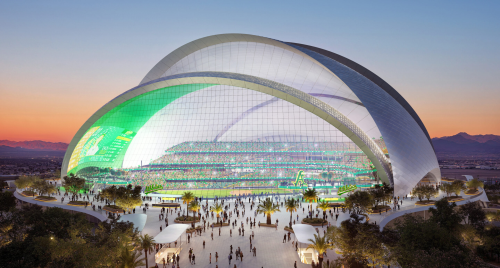
June 4th, 2024
The Oakland Athletics have requested to play up to eight home games per season away from their future $1.5 billion Las Vegas ballpark. This move could substantially undermine the financial projections that were presented last year when the team sought $380 million in public financing for the project.
The request, detailed in the team’s 37-page proposed 30-year non-relocation agreement, is at least double the number of neutral site home games agreed upon by other Major League Baseball franchises in their agreements. The Las Vegas Stadium Authority Board, which oversees operations for Allegiant Stadium and the planned A’s ballpark, is expected to vote on the agreement at its July 18 meeting.
Financial Concerns
Stadium Authority Chairman Steve Hill noted that negotiations with the A’s are ongoing. However, he emphasized that the number of home games played outside Las Vegas will impact the bonding capacity for the stadium, currently set at $120 million. Hill suggested that reducing the number of games played elsewhere could help maintain the necessary bonding capacity to finance stadium construction.
“If you eliminate 10 percent of the games that will be played at the stadium, chances are you’re going to eliminate about 10 percent of that bonding capacity,” Hill said.
Jeremy Koo, a Sacramento-based attorney and A’s fan, analyzed the economic impact of the lost home games, estimating annual projected losses of between $2.6 million and $3 million in incremental tax revenue, and between $65 million and $75 million in incremental spending.
“It is unclear why the A’s require the uncompensated right to play seven, much less eight, home games away from the proposed stadium yearly,” Koo wrote in a letter to the Stadium Authority board.
Previous Agreements and Comparisons
In recent non-relocation agreements for new ballparks in Miami, Atlanta, and Arlington, Texas, the teams agreed to no more than three “home” games at neutral sites per season. The A’s President David Kaval stated that the idea behind holding eight games outside of Las Vegas was to build the team’s brand, promote the club, and attract players and sponsors.
Kaval added that the negotiations with the Stadium Authority are still ongoing and that the eight-game figure was intended to provide flexibility while setting an upper limit on relocated games.
“We know in most years it’s expected to be way less,” he said.
Impact on Other Events and Financial Projections
Both Kaval and Hill mentioned that other events, including concerts, would be held at the new ballpark when the A’s are not using it. Jeremy Aguero, principal analyst at Las Vegas-based advisory firm Applied Analysis, highlighted that financial projections for the ballpark were based on multiple uses beyond baseball.
“Let’s imagine that the A’s don’t play a game or three games over a specific period,” Aguero said. “That also allows the stadium to be reprogrammed for some other use during that same period. The value of a stadium is not just game day. It is everything that happens outside of game day as well.”
Public financing for the stadium includes $180 million in transferable tax credits from the state, an estimated $120 million in Clark County bonds, and a $25 million credit from the county for infrastructure needs around the stadium. However, Hill emphasized that these types of events cannot be factored into the bonding capacity figure until after the ballpark’s construction is funded.
“We want to be conservative because you don’t want the bonds not being able to be repaid,” Hill said.
Historical Context and Future Plans
Since 1996, MLB teams have played in various international and domestic markets. The A’s have participated in six neutral site games in Tokyo and were the designated home team each year. Recent examples include games played in Seoul, South Korea, and Mexico City by other teams.
The non-relocation agreement is one of several required contracts specified in SB1, which was approved during Nevada Legislature’s special session last year. Construction on the ballpark needs to begin by April 2025 to ensure the stadium is ready for opening day in April 2028. Meanwhile, the A’s plan to play at a minor league ballpark in Sacramento for three years, starting in 2025.
A spokesman for Major League Baseball did not respond to requests for comment, and a spokeswoman for the MLB Players Association referred to the organization’s 2022-26 collective bargaining agreement.
Conclusion
The request by the Oakland Athletics to play more home games outside of Las Vegas could significantly impact the financial viability of their planned $1.5 billion ballpark. As negotiations continue, it remains crucial to balance the team’s brand expansion goals with the economic realities and commitments made to the city of Las Vegas.
General Disclaimer: This article is for informational purposes only and reflects the current understanding and opinions regarding the events described. The information provided is accurate to the best of our knowledge at the time of publication. Investing in public projects and sports infrastructure is speculative and involves risk. Financial projections can vary, and actual results may differ. Always verify details and consult with professionals before making any financial commitments based on this content.







